You may not find this terribly rewarding unless you're included here, so this is a good time for casual and random browsers to turn back before they get too caught up in the sweep and majesty of the proceedings and can't let go.
18-19 October 2018
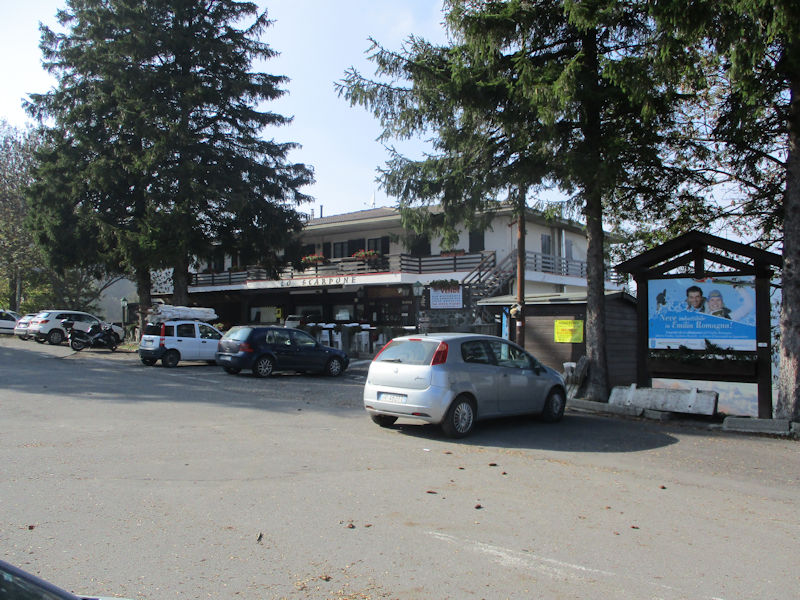
Following on from our traditional stop when coming over the Grand St-Bernard into Italy, the B+B L'Ospitalità del Castello in Settimo Vittone at the foot of the Aosta Valley, we've challenged our antiquated Volvo GPS to find us a driveable road through the mountains from Tortona. Our Volvo navigator did not do well (partially our fault), but we've made it to the 'ski resort' of the Passo Penice, overlooking the town of Bobbio down the far side. 19 October 2018.
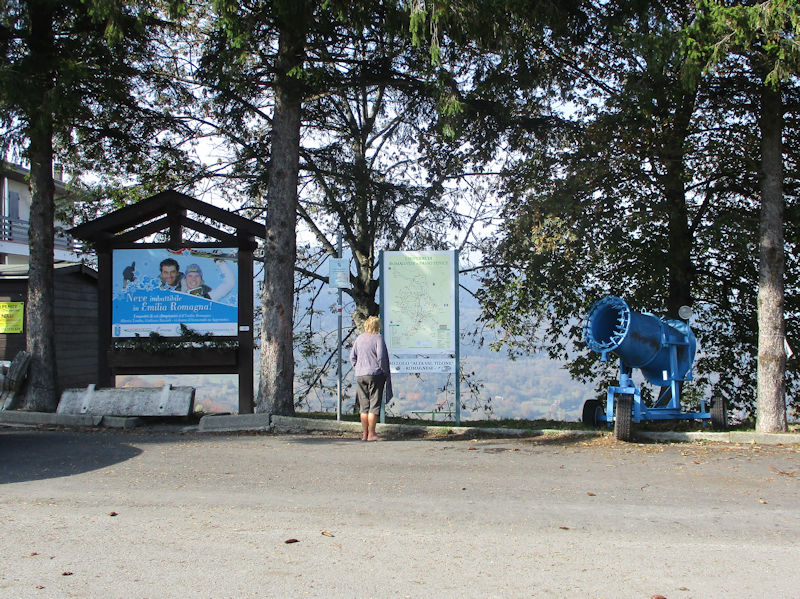
Monte Penice is the standout local mountain, at 1460m asl and with a famous Sanctuary of Santa Maria on the summit -- we're just at the Passo Penice, 1146m, and hungry again. That appears to be a snow cannon on the right, not surprising for a ski resort at 1146m.
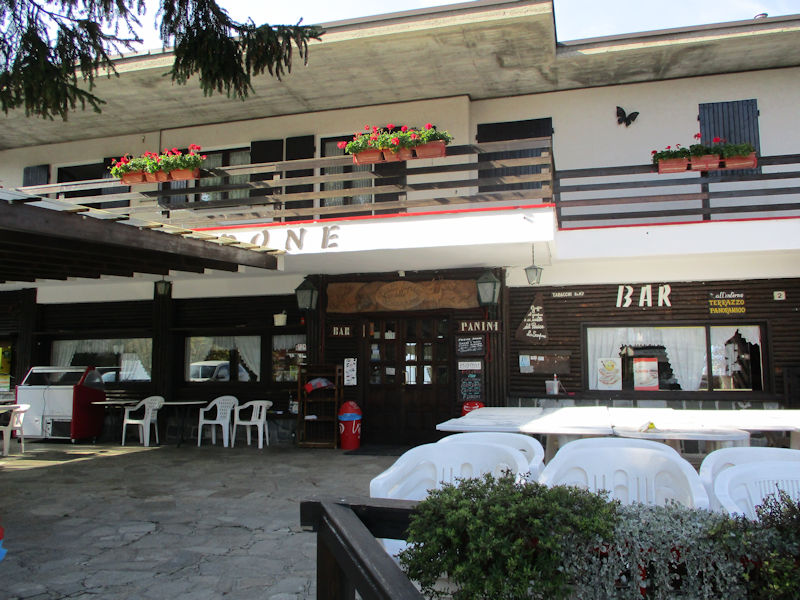
The Lo Scarpone restaurant rustles up an excellent piadina. At the pass, we're crossing over from the Lombardy region into the western edge of Emilia-Romagna.

Ski slopes below the restaurant

However odd the statue of the Irish monk St Columbanus (ca.540-615) may appear here, it makes perfect sense because he's also the patron saint of motorcycles.
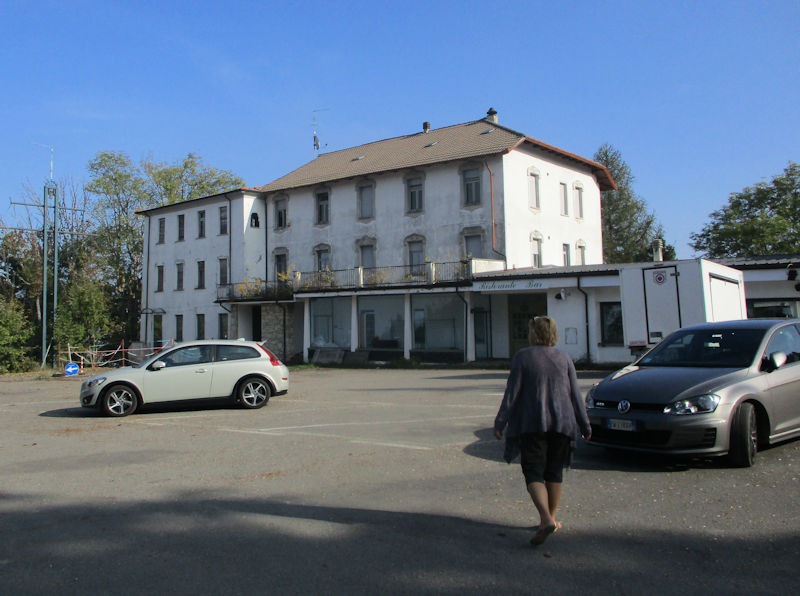
Back on the road. Mr Volvo GPS ran us in rather dangerous circles for a good while on the mountainside, but eventually . . .

. . . we and our friends Joe and Teny fetched up at the B+B La Torretta just outside of Bobbio on the Trebbia Valley road.

We've commandeered the two-room digs, Teny and Joe are in the single across the hall.

Cats are welcome, but alas must be locked up in the bathroom when we're out. Melvin seemed not to be too upset about that.

The owners are in the process of restoring various parts of the old buildings and are making a good job of it.
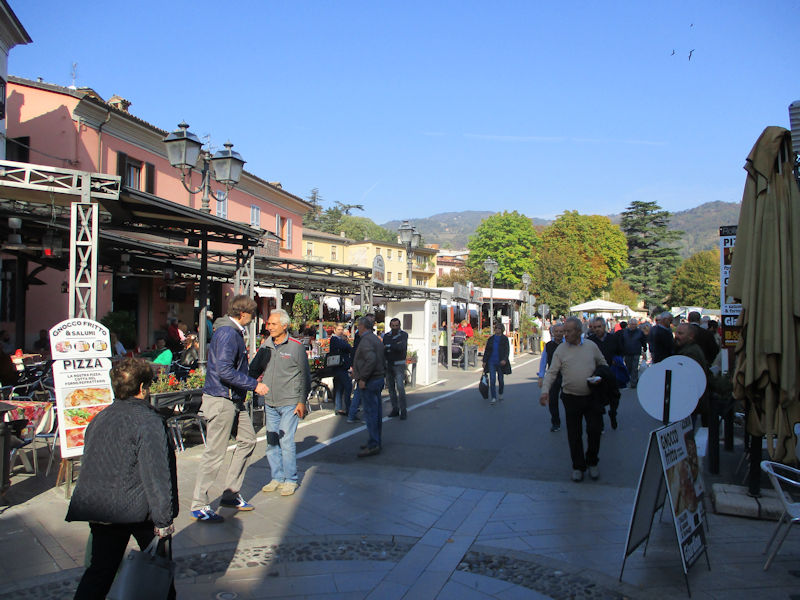
A Bobbio walkabout -- We're at the northern end of the centro storico, by the Piazza San Francesco, prepared to proceed . . .

. . . down the central street, the Contrada di Porta Nova, towards the Duomo ('contrada' could be used for a district of a town or to a street within it, overlapping uses probably).

The area round Bobbio had been settled by pre-Roman Ligurian peoples and was known to the Romans themselves, but it became a thriving and famous destination when in AD 614 the proselytizing Irish monk St Columbanus was given property here by the Longobard King Agilulf to found a new abbey. The monastery flourished and became a significant Christian cultural centre, especially for its scriptorium and library, originally following Columbanus' own Celtic (Irish) Christian rule but a few decades later adopting the then nearly universal Rule of St Benedict. The abbey's importance seems to have declined in the 15th century and its library was eventually dispersed.

The Duomo on a market day. The habitations and infrastructure that had built up around the monastery are said to have been officially recognized as an imperial city (with city walls) and as an episcopal see in 1014. Fittingly, the originally-Romanesque Cattedrale di Santi Maria Assunta became the seat of the bishop's diocese (as distinct from the abbey) in 1075, though the façade with three Gothic portals was added in 1463. The adjacent Bishops' Palace also dates from the 11th century, but was restructured in the 15th. The belltower and clock tower were apparently not completed until 1532.

The interior is a classic nave with two aisles, or 'three-aisled' Latin cross, with chapels along the side walls.
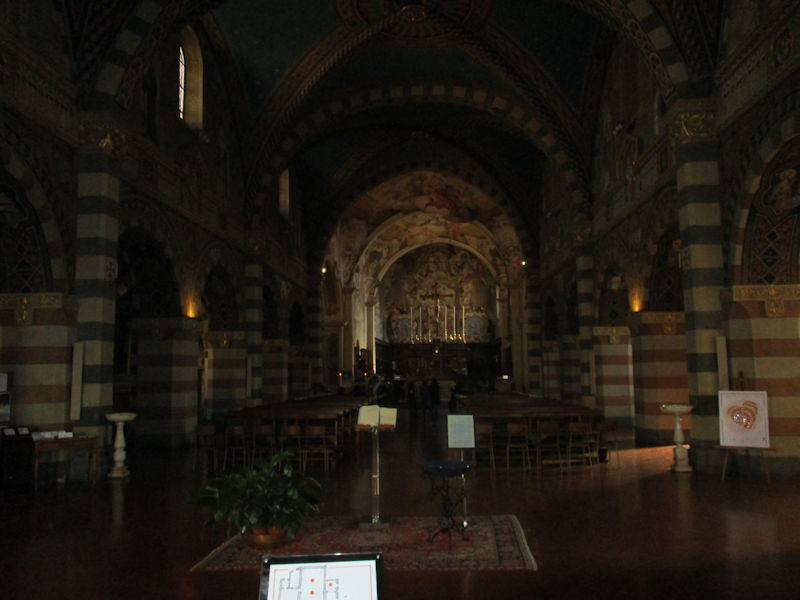
The nave. It's very dark in here! (There's no place to drop a euro in the slot and get the lights turned on for two minutes.)

The fine baptismal font, apparently in ivory, with a lockable lid to keep the witches from stealing the holy water.

The Last Supper in one of the chapels. In addition to the traditional bread rolls, the main course seems to be a badger or opossum, something like that. Much of the interior decoration is from the 19th century, but there is evidently a good 15th century fresco of the Annunciation in a chapel off the right transept that we missed entirely.

The altar on a raised presbytery and 16th century cross in the apse

A brighter view of the nave and altar

The rest of our party joins us on our way down to the river.
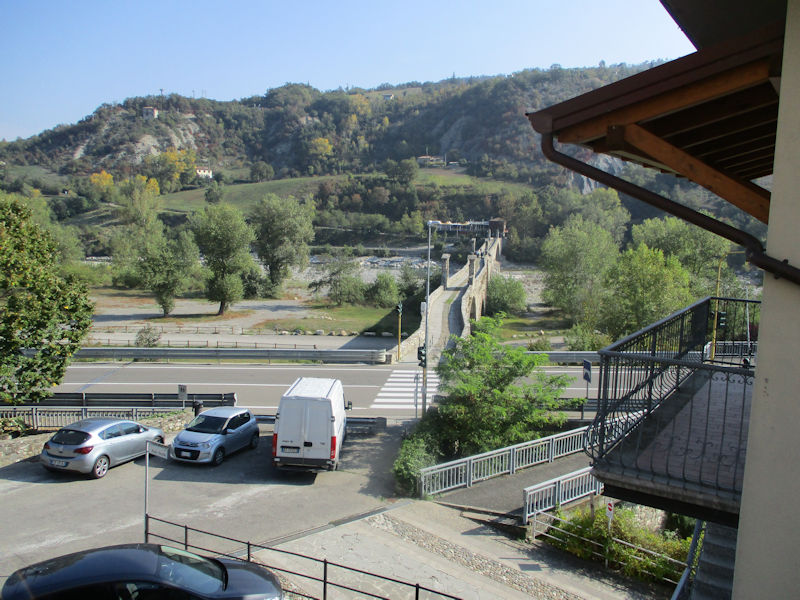
The Ponte Vecchio over the river Trebbia. The Trebbia flows northward out of the Ligurian Apennine mountains about 120km to join the Po just west of Piacenza. Its banks, sometimes gentle but in some upstream places virtually gorges, have been occupied since Palaeolithic and especially since Neolithic times, and Etruscan artefacts have been found from the 5th century BC.

The Ponte Vecchio or 'old bridge' is very old indeed, certainly from before 1196, and may have Roman origins. Presently a symbol of Bobbio itself, it's also known as the Ponte Gobbo, or Hunchback Bridge.

It's also known, like most surviving medieval bridges perhaps, as the Ponte del Diavolo or Devil's Bridge: "the famous legend tells that it was built by the Devil in one night after he made a pact with Saint Columbanus who promised him the soul of the first passerby; but when the bridge was finished the Irish Saint sent a dog" [Wikipedia]. (Only the saint himself is missing from the tale about the Magdalena Bridge in the Garfagnana above Lucca just over the mountains.)
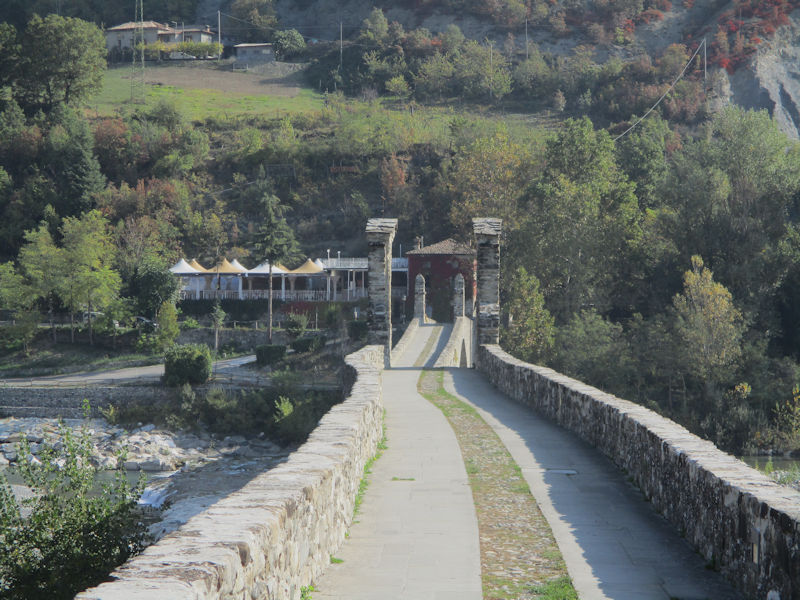
Coming up on the hunchback

The river Trebbia is perhaps best known historically for its being -- on 'flat land' farther downstream in the valley of the Po -- the site of the first major battle of the Carthaginian Hannibal's invasion over the Alps, December 218 BC, in which a large army of Roman legionaries was destroyed and the survivors were pursued back to the Roman base in Placentia (modern Piacenza).

There is a life-size monument to Hannibal and his friends farther downstream near the Castello di Rivalta, one of the likely sites at which the battle might have taken place. The photo is from our visit to Rivalta a few years ago.
|
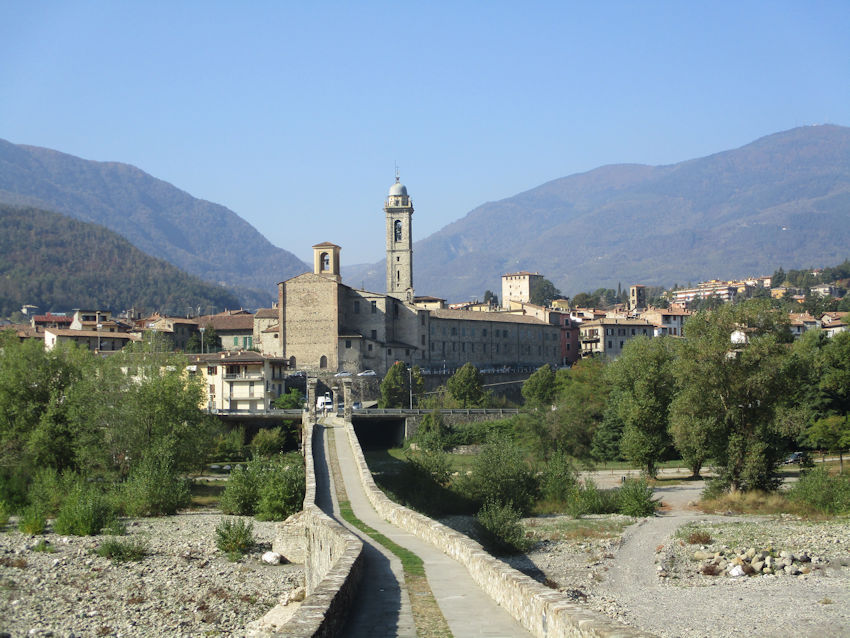
A look back at downtown Bobbio, a compact town of fewer than 4,000 Bobbiesi at 272m asl, with the back of the Duomo front and centre and Monte Penice, 1460m, up on the right.
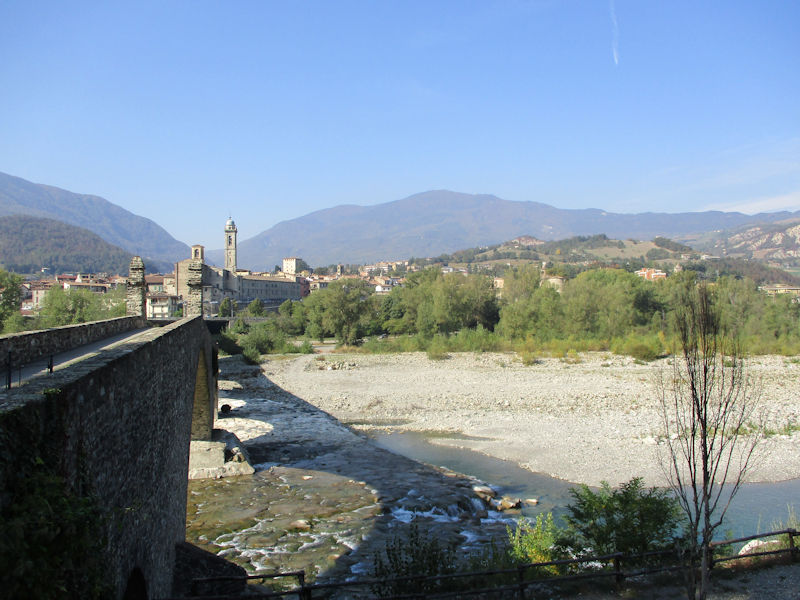
The river Trebbia, perhaps resting up for next spring's snow-melt floods
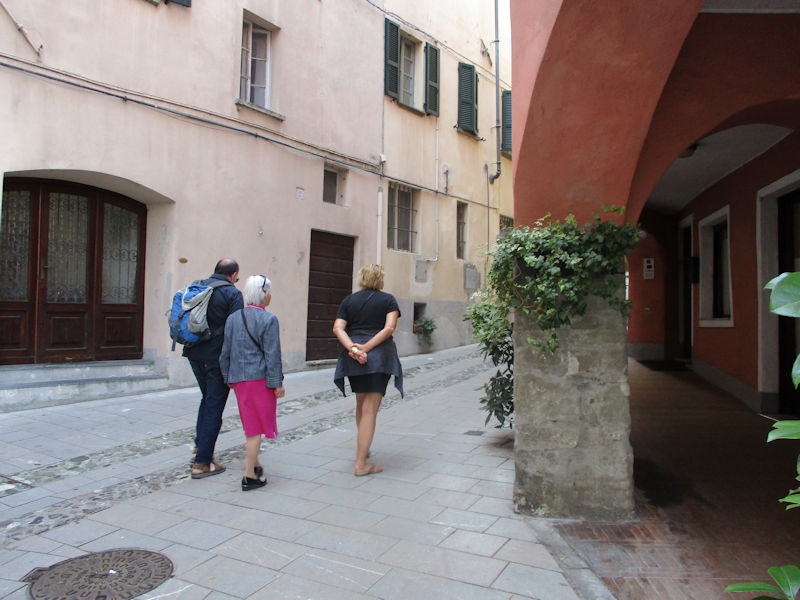
Trekking back to the Piazza Duomo
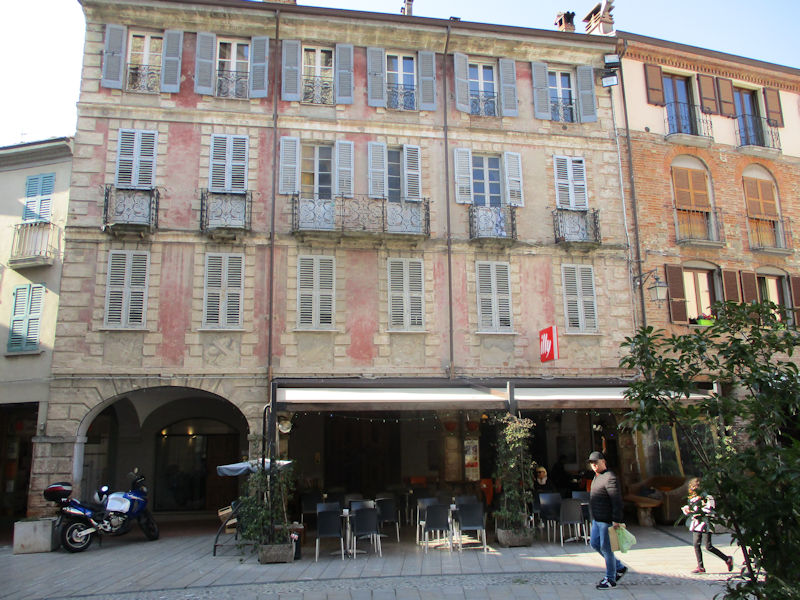
In the Piazza Duomo, facing the cathedral. Bobbio had become a free municipality by the early 12th century and was later a member of the Lombard League, formed in 1167 to resist the attempts by the Emperor Friedrich I Barbarossa to bring the northern Italian cities back under imperial control -- Bobbio's troops participated in the League's victory in the Battle of Legnano, May 1176, which convinced Barbarossa to give up his dreams of hegemony and turn to diplomacy instead.
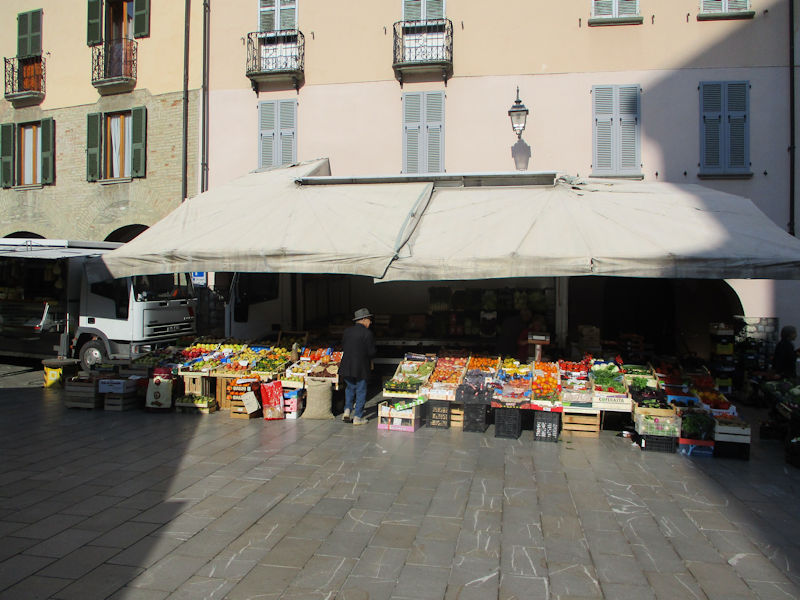
In subsequent years, Bobbio was a property first of Piacenza, after 1230, then of the Malaspina family of the Lunigiana region east of Genoa (1304-1341), next of the Visconti lords of Milan, who ceded it as a fief to supporters from the Dal Verme family (1436), who were hanged as rebels in 1500 when the French army successfully besieged the city.

The French created the Marquisate of Bobbio in 1516 and entrusted it to their loyal commander Galeazzo Sanseverino -- when he died in the French defeat at the Battle of Pavia in 1525, the Dal Vermes were back and remained until 1759, as a property of the Farnese Duchy of Parma and Piacenza and then of Austria, Napoleon's Ligurian Republic after 1796, and finally of the Savoyard Kingdom of Sardinia until that became the new Kingdom of Italy from 1859.

Bobbio street scene: the Contrada dell'Ospedale, just near the Abbey over to the right. The Republic of Bobbio was recreated by the anti-fascist partisans in July 1944, the first free city in northern Italy, which lasted until the Germans counterattacked in the Battle of the Penice in late August. Liberation took place in March 1945.

This is St Columbanus' own church at the far side of the monastery facilities. The original 7th century abbey and church (the Abbazia di San Colombano) was built some four miles from here near the salt works that made the region so economically important, sited along the road linking Piacenza nearby with Genoa over the mountain pass. Management (and profits) were shared at first with the Lombard Dukes but later became solely owned by the monks.
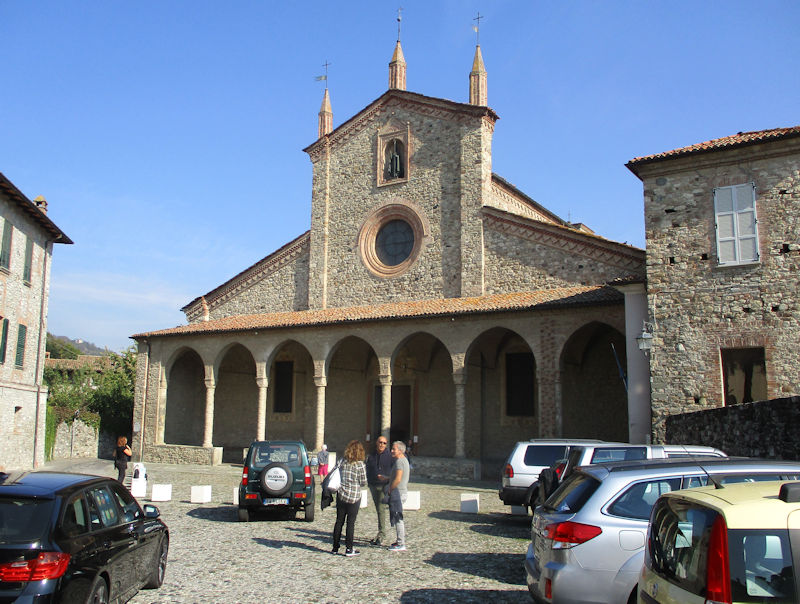
The present Renaissance-style Basilica of St Colombanus was built here in town between 1456 and 1530 on a Latin cross with a nave and two aisles and a rectangular apse. (I think I recall that the beautiful portico is a later addition.)

The nave and rectangular apse
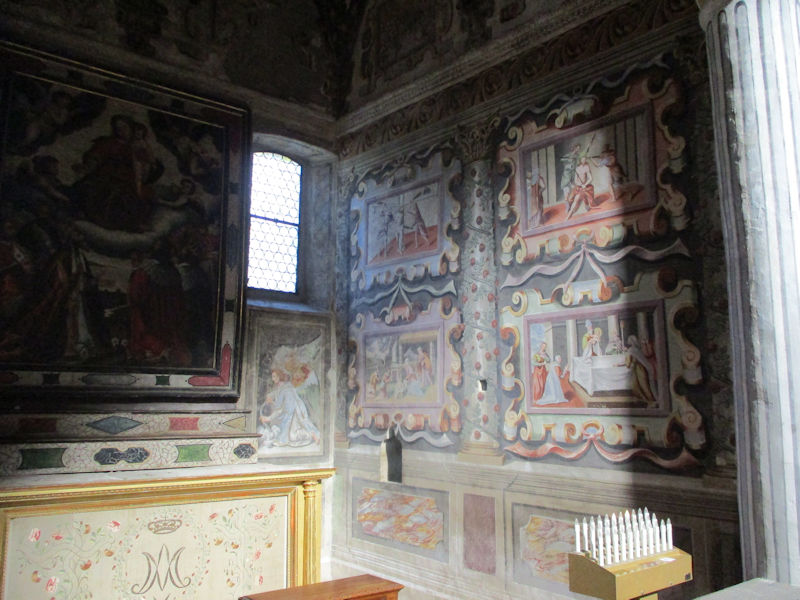
The frescos are attributed to Bernardino Lanzani ('Bernardino Colombano') active in 16th century Pavia and Bobbio.

The ambo, looking into the right transept

A Madonna and a St Catherine of Alexandria with a much bigger wheel than required, a cute little bunny in the foreground, and two naked kids playing sophisticated musical instruments

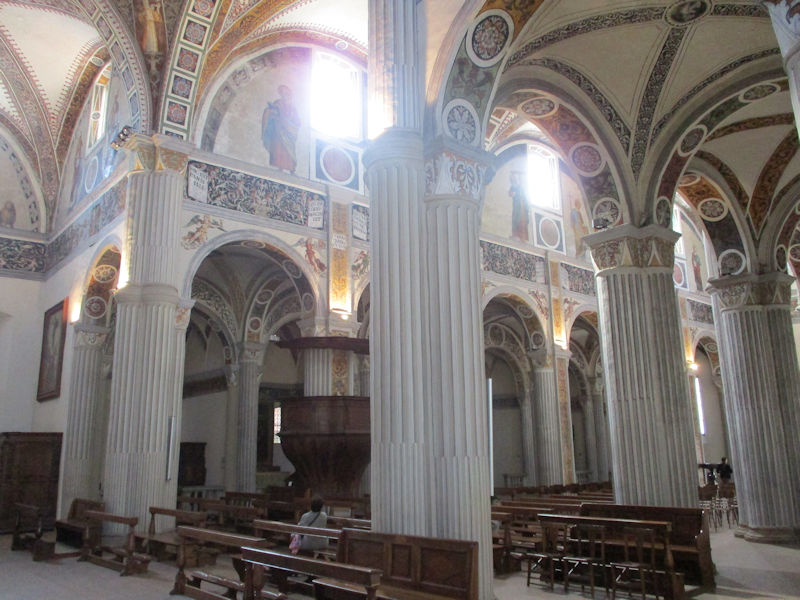
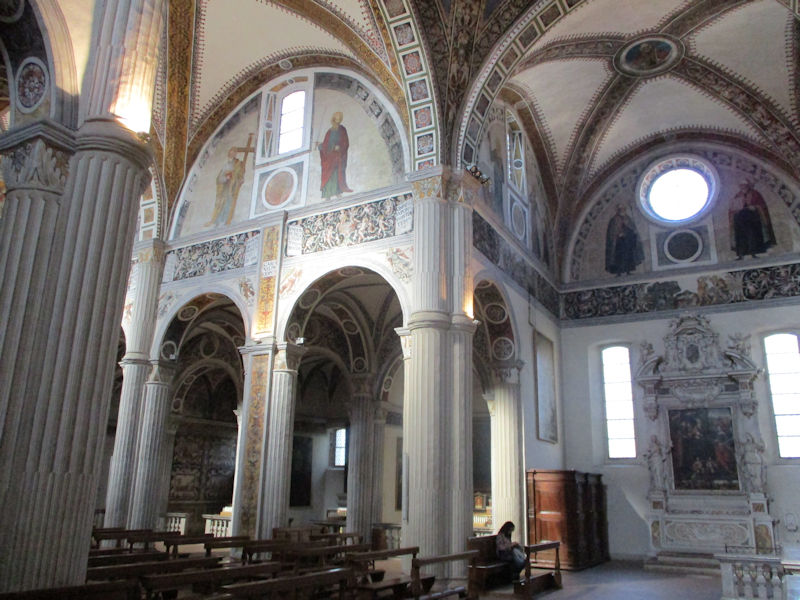

The crypt itself is ascribed to the 15th century but it houses this fine 12th century mosaic pavement depicting the history of the Maccabeans and the Cycle of the Months.


The battle against the dragons

The deaths of the pagans
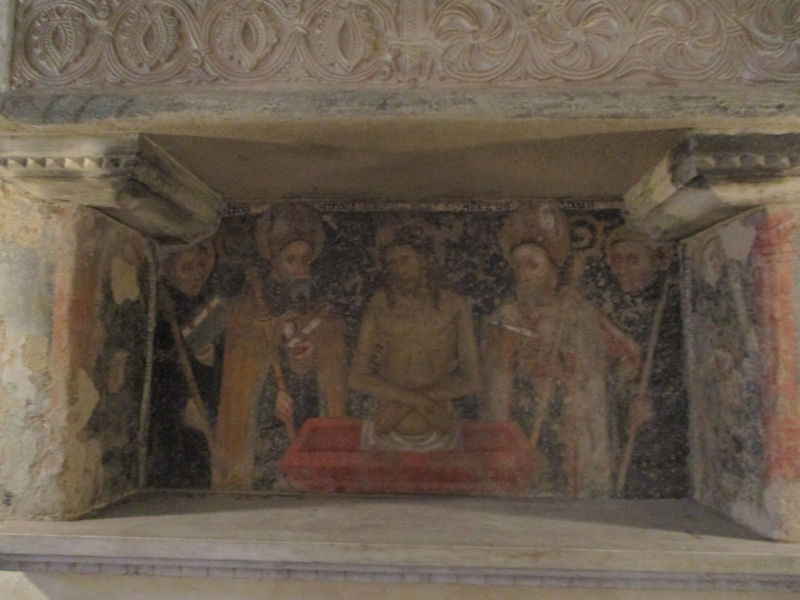
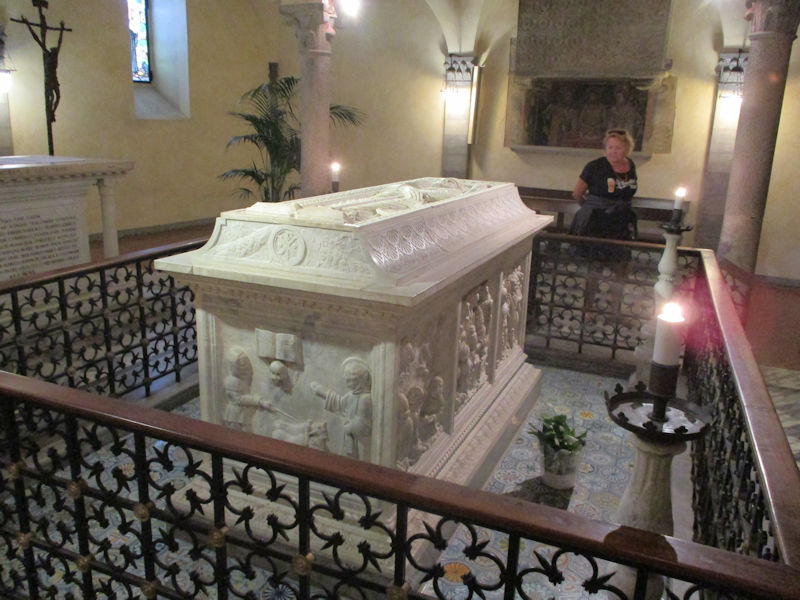
The sarcophagus of St Columbanus his own good self, made in 1480

Scenes from the life of Columbanus. His two immediate successors, St. Attala and St. Bertulf, have their own 'resting places' here as well.
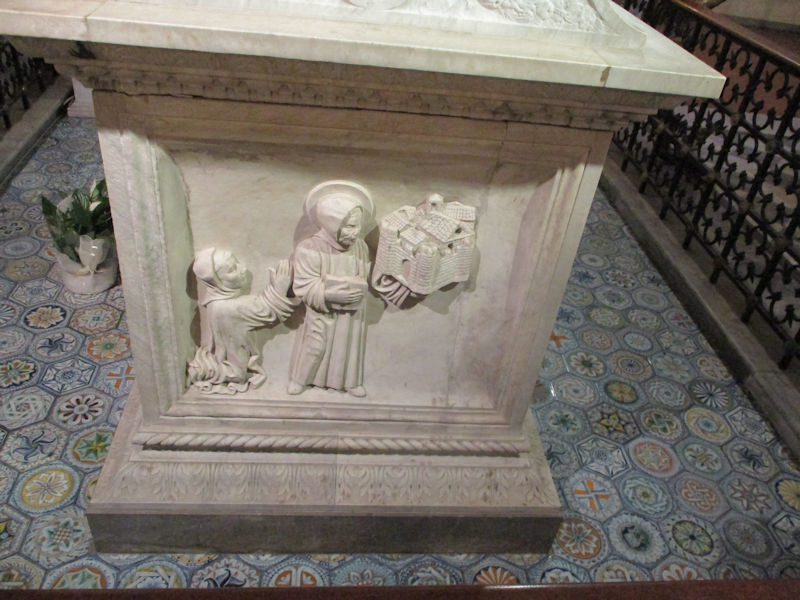
The building of the abbey, and a fine mosaic floor

There are two museums in the Abbazia di San Colombano, one of the abbey itself and the other the Museo Civico of the town, which are closed today (of course) -- we've been through the corridor from the basilica along the cloister out to the Piazza Santa Fara, where market day is starting to pack things up.

How disappointed they look: navigating Italian opening hours takes great skill and planning and is probably impossible.


But we have dinner to anticipate happily.

A look-in at the tourist office on the left (closed) and the Chiesa di San Francesco, proudly mentioned on the tourist brochures but obviously off-limits for some decades at least.

 Dwight Peck's personal website
Dwight Peck's personal website






















































